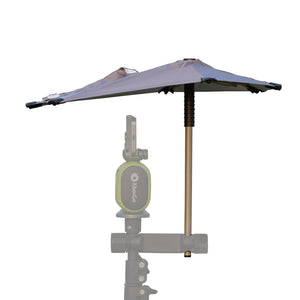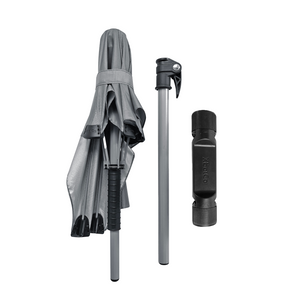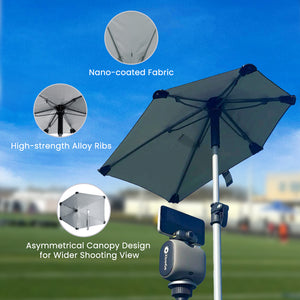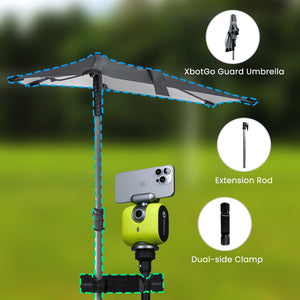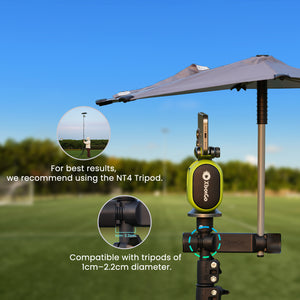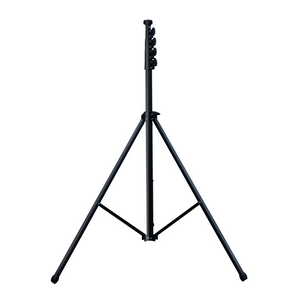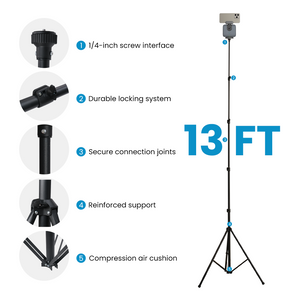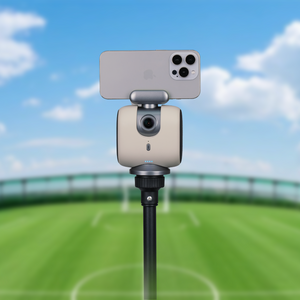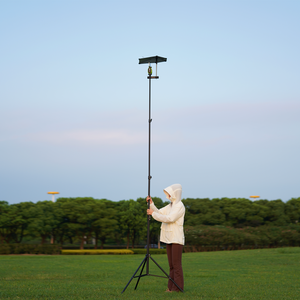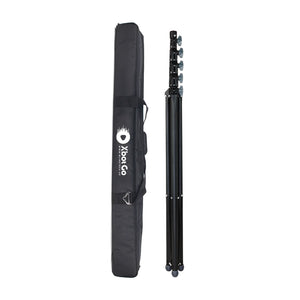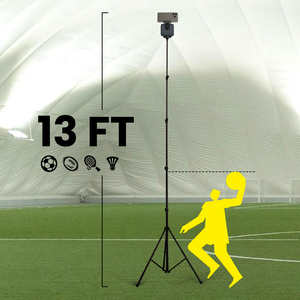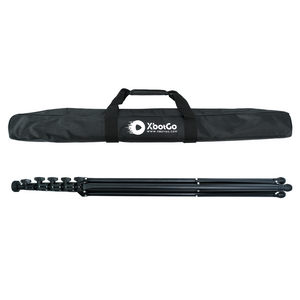XbotGo Chameleon AI Sports Camera
Posiciones en el fútbol: La guía completa para comprender cada rol
Tanto si eres nuevo en el fútbol como si buscas profundizar en este deporte, dominar las 11 posiciones es esencial. A diferencia de los cinco roles claramente definidos del baloncesto o las unidades especializadas del fútbol americano, las posiciones en el fútbol combinan fluidez y estructura, creando un panorama táctico complejo pero fascinante.
Desde el sistema de numeración tradicional del 1 al 11, originado en la década de 1920, hasta formaciones modernas como el 4-3-3 y el 3-5-2, comprender los roles de los jugadores ayuda a descubrir la profundidad estratégica del fútbol. Esta guía completa desglosa cada posición en el campo, explorando sus responsabilidades, habilidades requeridas y cómo han evolucionado en el fútbol moderno.
La Fundación: El sistema de numeración de posiciones del fútbol
Orígenes históricos y relevancia moderna
El icónico sistema de numeración del fútbol (del 1 al 11) proporciona un lenguaje universal que trasciende formaciones y variaciones tácticas. Si bien hoy en día los números de camiseta suelen reflejar la preferencia del jugador más que la posición, el sistema tradicional sigue siendo crucial para comprender los roles:
Números de posición tradicionales:
- 1 – Portero
- 2 – Lateral derecho
- 3 – Lateral izquierdo
- 4 – Defensa central
- 5 – Defensa central/Líbero
- 6 – Centrocampista defensivo
- 7 – Centrocampista derecho/Extremo
- 8 – Mediocampista central
- 9 – Delantero
- 10 – Centrocampista ofensivo/Creador de juego
- 11 – Centrocampista izquierdo/Extremo
Comprender las formaciones de fútbol
Las formaciones describen cómo se organizan los 10 jugadores de campo, siempre ordenados de defensa a ataque. Un 4-4-2 significa cuatro defensores, cuatro centrocampistas y dos delanteros. Las formaciones comunes incluyen:
Formaciones modernas populares:
- 4-4-2: Enfoque clásico equilibrado
- 4-3-3: Ataque de amplitud con control del mediocampo
- 3-5-2: Sistema de alas laterales para mayor amplitud
- 4-2-3-1: Un solo delantero con apoyo del mediocampo ofensivo
- 5-3-2: Solidez defensiva con amenaza de contraataque
Posiciones defensivas: la base del éxito del equipo
Portero (#1): La última línea de defensa
El portero es, sin duda, la posición más especializada del fútbol. Al ser el único jugador con permiso para usar las manos dentro del área, se enfrenta a desafíos físicos y mentales únicos.
Responsabilidades principales:
- Detención de tiros y protección de portería
- Organizando la línea defensiva
- Distribución para iniciar ataques
- Dominar el área penal en centros y jugadas a balón parado
Habilidades esenciales:
- Reflejos ultrarrápidos
- Excelente posicionamiento y comprensión del ángulo.
- Fuerte comunicación y liderazgo
- Resiliencia mental para manejar errores
- Habilidad moderna para jugar a la pelota
Evolución del Puesto:
Los porteros actuales deben ser "líberos", cómodos jugando con los pies y actuando como undécimo jugador de campo durante las fases de posesión. Esta evolución exige habilidades técnicas tradicionalmente asociadas a los jugadores de campo.
Defensas centrales (#4, #5): Los pilares defensivos
Los defensores centrales forman el núcleo defensivo, tradicionalmente centrado en evitar goles a través del dominio físico y la disciplina táctica.
Funciones principales:
- Marcar a los delanteros rivales
- Ganando duelos aéreos
- Organizando la línea defensiva
- Despejando situaciones peligrosas
- Construyendo el juego desde atrás
Requisitos físicos y técnicos:
- Altura y fuerza para batallas aéreas
- Velocidad para recuperarse tras una paliza
- Compostura bajo presión
- Capacidad de pase preciso
- Inteligencia táctica para el posicionamiento
Variaciones modernas:
- Defensa central con juego de balón: inicia ataques con pases progresivos
- Stopper: Defensor agresivo que se adelanta para desafiar.
- Barrendero: Cubre detrás de la línea defensiva (menos común hoy en día)
Laterales (#2, #3): Jugadores modernos de dos vías
Los laterales se han transformado desde roles puramente defensivos a salidas de ataque cruciales, que requieren una condición física excepcional y una flexibilidad táctica.
Responsabilidades defensivas:
- Marcar a los extremos rivales
- Prevenir centros desde zonas amplias
- Apoyando a los defensas centrales
- Manteniendo la forma defensiva
Atacando Contribuciones:
- Tramos superpuestos para proporcionar ancho
- Centros al área
- Creando sobrecargas en áreas amplias
- Goles ocasionales desde posiciones avanzadas
Exigencias físicas:
Los laterales suelen cubrir la mayor parte del terreno durante los partidos, alternando constantemente entre funciones defensivas y apoyo ofensivo. Esto requiere una resistencia y una velocidad de recuperación excepcionales.
Posiciones del mediocampo: La sala de máquinas
Mediocampista defensivo (#6): El héroe anónimo
Los centrocampistas defensivos, a menudo pasados por alto pero cruciales, protegen a la defensa de cuatro mientras inician movimientos de ataque.
Responsabilidades clave:
- Desmantelando los ataques de la oposición
- Proporcionar una salida de pase para los defensores
- Proyectando la defensa
- Controlar el ritmo del juego
- Distribución de pelota simple
Inteligencia táctica:
Los mejores centrocampistas defensivos leen el juego excepcionalmente bien, posicionándose para interceptar pases y desbaratar los ataques antes de que se desarrollen. Deben encontrar el equilibrio entre cuándo presionar y cuándo mantener la formación.
Variaciones notables:
- Destructor: Concéntrese en recuperar el balón
- Armador de juego profundo: combina tareas defensivas con pases creativos.
- Box-to-Box: Cubre terreno en ambas fases
Mediocampista central (#8): El jugador completo
Los mediocampistas centrales representan la posición más exigente del fútbol y requieren excelencia en todos los aspectos del juego.
Funciones integrales:
- Vinculando defensa y ataque
- Cobertura de caja a caja
- Creando ocasiones de gol
- Apoyo defensivo
- Mantener la posesión
Atributos requeridos:
- Resistencia y ritmo de trabajo excepcionales
- Competencia técnica
- Conciencia táctica
- Rango de pase
- Capacidad de marcar goles
Los mejores centrocampistas centrales combinan la disciplina defensiva de un #6 con el estilo creativo de un #10, lo que los hace invaluables para los equipos modernos.
Centrocampista ofensivo (#10): El genio creativo
La posición número 10 ha producido a los jugadores más emblemáticos del fútbol, encargados de desbloquear las defensas a través de la visión y la técnica.
Responsabilidades creativas:
- Enhebrando bolas
- Creando espacio en zonas congestionadas
- Puntuación desde posiciones avanzadas
- Vinculando el mediocampo con el ataque
- Entrega de piezas preparadas
Cualidades esenciales:
- Primer toque excepcional
- Visión para detectar oportunidades
- Capacidad técnica en espacios reducidos
- Compostura bajo presión
- Instinto goleador
Centrocampistas abiertos/extremos (#7, #11): Proporcionan amplitud y ritmo
Los jugadores abiertos estiran las defensas horizontalmente, creando espacio para sus compañeros y al mismo tiempo amenazando los goles.
Rol de extremo tradicional:
- Derrotando a los defensores 1 contra 1
- Entregar centros
- Retrocediendo defensivamente
- Extendiendo el juego
Evolución moderna:
- Extremos invertidos: corte hacia dentro con el pie más fuerte
- Delanteros abiertos: mayor concentración goleadora
- Centrocampistas abiertos: Mayor responsabilidad defensiva
Posiciones delanteras: Los goleadores
Delantero (#9): El punto focal
Los delanteros son los principales responsables de marcar goles, pero en el fútbol moderno contribuyen mucho más.
Funciones principales:
- Convertir ocasiones en goles
- Juego de atraco
- Creando espacio para otros
- Liderando la prensa
- Amenaza aérea
Fortaleza mental:
Los delanteros deben mantener la confianza durante las sequías de gol y, al mismo tiempo, seguir contribuyendo al juego del equipo. La presión por marcar crea desafíos psicológicos únicos.
Variaciones tácticas:
- Hombre objetivo: Presencia física para balones largos
- Poacher: Finalizador instintivo en el área
- Falso 9: Cae profundamente para crear espacio
- Presionando hacia adelante: Inicia acciones defensivas
Delanteros de apoyo: Amenazas creativas de gol
Los segundos delanteros y los extremos operan entre posiciones tradicionales, combinando creatividad con amenaza de gol.
Responsabilidades clave:
- Apoyando al delantero principal
- Creando oportunidades para otros
- Anotación desde posiciones más profundas
- Presión defensiva
- Flexibilidad posicional
Tecnología moderna en el análisis de posiciones
Cómo la IA mejora la comprensión del juego posicional
Si bien comprender las posiciones tradicionales sienta las bases, la tecnología moderna ofrece información sin precedentes sobre cómo los jugadores desempeñan sus roles. Los sistemas avanzados de cámaras con IA pueden rastrear el movimiento de los jugadores, analizar patrones de posicionamiento y proporcionar retroalimentación objetiva que ayuda a jugadores y entrenadores a optimizar el rendimiento.
Por ejemplo, el sistema XbotGo Chameleon utiliza seguimiento basado en IA para seguir a jugadores específicos durante los partidos, capturando su posicionamiento, patrones de movimiento y toma de decisiones. Esta tecnología es especialmente valiosa para:
Desarrollo específico del puesto:
- Defensores: Analizar la coordinación de la línea de fuera de juego y las carreras de recuperación.
- Centrocampistas: Seguimiento del ritmo de trabajo y redes de pases
- Delanteros: Estudiar patrones de movimiento que crean oportunidades de gol.
La función de reconocimiento de dorsales permite a los entrenadores revisar el rendimiento completo de cualquier jugador en el partido, no solo los momentos en que está cerca del balón. Este análisis exhaustivo ayuda a identificar fortalezas y áreas de mejora que la observación tradicional podría pasar por alto.
Beneficios del desarrollo juvenil:
Para los jugadores jóvenes que aprenden posiciones, el análisis de IA proporciona retroalimentación objetiva sobre la posición y el movimiento. Padres y entrenadores pueden revisar las grabaciones juntos, lo que ayuda a los jugadores a comprender sus roles de forma más eficaz que con instrucciones verbales únicamente.
Elegir su puesto: factores a considerar
Atributos físicos
Diferentes posiciones favorecen distintos tipos de cuerpo y capacidades físicas:
Ventajas de la altura:
- Porteros (alcance y presencia imponente)
- Defensas centrales (dominio aéreo)
- Goleadores objetivo (juego de retención)
Velocidad y agilidad:
- Fullbacks (carreras de recuperación)
- Extremos (superando a los defensores)
- Centrocampistas ofensivos (giros rápidos)
Requisitos de resistencia:
- Centrocampistas centrales (cobertura de área a área)
- Laterales (transiciones constantes)
- Presionando hacia adelante (carreras de alta intensidad)
Habilidades mentales y técnicas
Puestos de liderazgo:
- Portero (organizando la defensa)
- Defensa central (capitán defensivo)
- Mediocampista central (entrenador en el campo)
Posiciones creativas:
- Centrocampista ofensivo (visión e imaginación)
- Extremos (estilo individual)
- Segundo delantero (encontrando espacio)
Posiciones tácticas:
- Centrocampista defensivo (leyendo el juego)
- Fullback (equilibrando ataque y defensa)
- Falso 9 (crear espacio para otros)
Flexibilidad de posición en el fútbol moderno
El auge de los jugadores versátiles
El fútbol moderno valora cada vez más a los jugadores que pueden desempeñar múltiples roles. Esta versatilidad proporciona flexibilidad táctica y aumenta el valor de los jugadores para sus equipos.
Combinaciones de posiciones comunes:
- Defensa central/Mediocampista defensivo
- Lateral/Extremo
- Centrocampista central/Centrocampista ofensivo
- Extremo/Delantero
Fluidez táctica
Las posiciones hoy en día son más flexibles que nunca. Un extremo derecho podría pasar la mayor parte del partido en zonas centrales, mientras que un mediocampista defensivo podría avanzar hacia posiciones de ataque. Esta fluidez requiere:
- Inteligencia posicional: comprensión de roles múltiples
- Versatilidad técnica: Habilidades para diferentes posiciones
- Conciencia táctica: saber cuándo cambiar de roles
- Comunicación: Coordinación con compañeros de equipo
Conclusión: Dominando las posiciones del fútbol
Comprender las posiciones del fútbol sienta las bases para apreciar la complejidad táctica del juego. Desde las responsabilidades únicas del portero hasta la responsabilidad goleadora del delantero, cada posición aporta elementos esenciales para el éxito del equipo.
Recuerda que, si bien las posiciones proporcionan estructura, la belleza del fútbol reside en la interpretación creativa de estos roles. Los mejores jugadores comprenden las exigencias de su posición y encuentran maneras únicas de influir en el juego. Empieza con los fundamentos de esta guía y luego desarrolla tu propio estilo en la posición elegida.
XbotGo Chameleon AI Sports Camera
Capture every moment with AI-powered tracking. Perfect for coaches, parents, and athletes who want seamless footage without manual filming.







 Soccer
Soccer Basketball
Basketball Ice Hockey
Ice Hockey Rugby
Rugby










